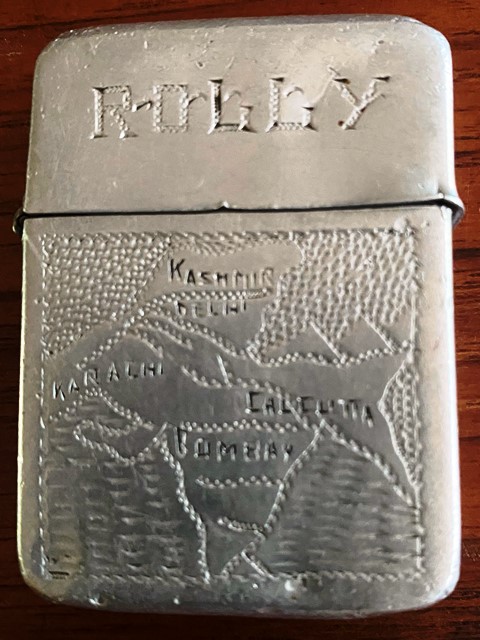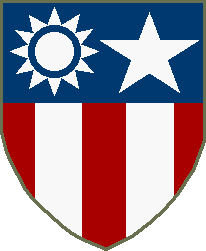ROLAND E. RAMLOW, Sr.
330th Engineer Regiment
My dad, Roland Ramlow, Sr., was a S/Sgt. with the 330th Engineer Regiment working on the Ledo Road. Below are his recollections of his service which he included in a family history that he prepared in his retirement years. The words are mostly his, any mistakes are mine.
- Roland E. Ramlow, Jr.
Roland Ramlow, Sr. was inducted in the Army at Fort Niagara, NY, March 16, 1943. After six-weeks basic training starting the first of April 1943 at Ft. Belvoir, VA, he was sent to the University of Kentucky for a three month course in drafting and map making after which he returned to Ft. Belvoir.
After a train ride to the West Coast, shortly after Thanksgiving 1943, he boarded the Admiral Benson in Los Angeles Harbor with 3,000 other soldiers for a 30 day unescorted voyage to Bombay Harbor. The vessel was brand new and could cruise at 30 knots. "We were supposed to be happy to learn this since they were going to sail on a direct course, unescorted, and could outrun any Japanese subs." ( RER, Jr. -- guessing that they may have been told this to settle any nerves but my dad had his doubts.)
The soldiers left the ship on New Years Eve and marched 5 miles to an overnight camp that fed 3,000 men. From there they took a train ride for a 5-day trip across India to Calcutta and stayed at Kamphapara, ten miles outside Calcutta. He and four other non-coms were then detailed to guard a train load of airplane engines for a 4-day trip to Ledo in Northern Assam. They lived in a boxcar for the four-day trip and slept on rope and bamboo beds they had purchased in Calcutta. Their beds had completely disintegrated from their "smooth" train ride. They brought K-rations, a tank of clean water, and 5 carbines with ammunition.
At Ledo they escorted the engines by truck to camp outside of Myitkyina, Burma. This was a harrowing ride for the roads were were mostly a slippery wet clay especially through Pangsau Pass at the top of the Patkai Range of mountains, one of the wettest places on earth. At Myitkyina, they reported to Headquarters Company of the 385th Battalion. They were in charge of engineering and construction supervision. His first job was to help surveying for a new 100 ton Bailey bridge to cross the Irrawaddy River. The 100-ton Bailey bridge mentioned has a back story because he took a picture of it of it and sent it home to my mom who had started working for the Syracuse District Corps of Engineers. She showed it to her boss, Captain Phoman who yelled “Hey that’s our bridge”. The parts for that bridge were designed and built by the very office where my mom was working. They had no idea where their bridge was being sent and the picture was then published in her office news letter. After the Bailey bridge survey he then worked surveying for realignment improving the Ledo Road.
On August 6, 1945, they received word that that the Air Corps had dropped an atomic bomb on Hiroshima. They all stood around dumbfounded. There were no cheers, but they just quietly talked and most felt that surely the war would be over. On August 9 when a second atomic bomb dropped on Nagasaki they all knew that it was all over. Not until the 14th when the Japanese surrendered did they know that it was time to rejoice – they would be going home. But there was a lot of work to do. Clean up earthmoving equipment, trucks, jeeps, rock crushers, kitchen and other equipment.


CBI / Taj Mahal Zippo lighter
ENLARGE
|
They packed up equipment on trains and drove to Chouboy Airport to board airplanes to Calcutta and then onto a ship to Seattle. In Seattle they marched off the ship and lined up in front of the welcoming committee that was made up of lovely women with big smiles. They were all ready for a nice cold glass of - not beer – but milk which they hadn't tasted for some time. They spent the night at a beautiful camp overlooking Puget Sound where they had a great dinner prepared by German POWs. Clearly it was GOOD to be back in the USA.
From there he took a train to Kansas for discharge on March 20, 1946, and returned to Syracuse, NY, where he had worked as a civilian draftsman with the Corps of Engineers before the war. He stayed with the Corps of Engineers, and in the fall of 1946, the entire Syracuse District office was combined with the Baltimore District.
In Baltimore, he attained a professional engineering license and retired with 34 years of Federal Service, serving as a mechanical and civil engineer. He retired as Chief of the Industrial Facilities Section in the military branch engineering division, Baltimore District, in 1973.
On art staff, 330th Regimental History.
|


